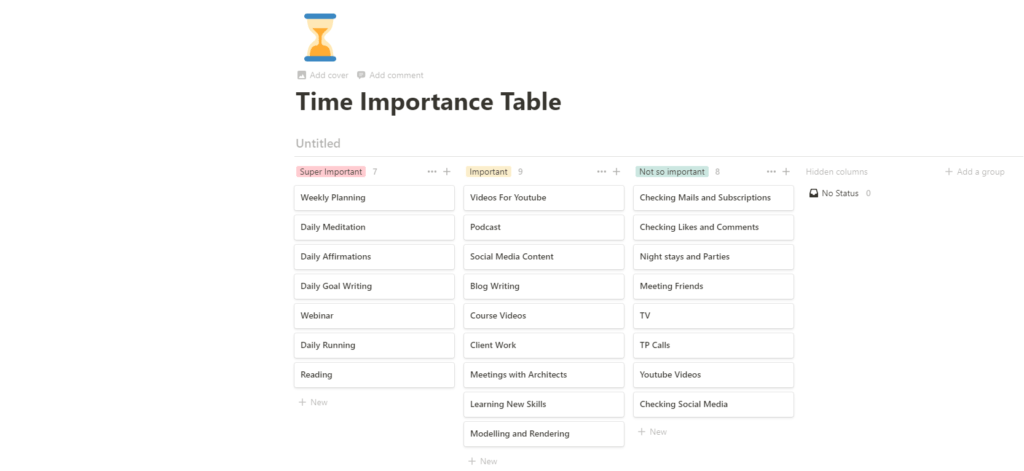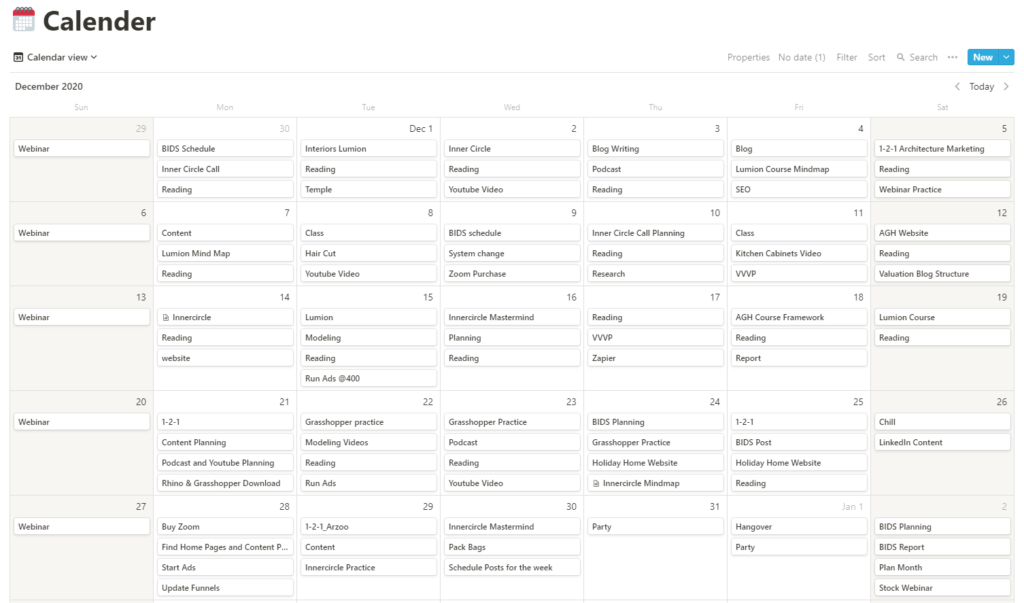Contents
-
Why Do You Need To Manage Time As Architecture Students?
-
Time Management Tips
-
Tools To Manage Your Time.
Why Do You Need To Manage Time As Architecture Students?
Did you know, according to The National Study of Student Engagement of Indiana University,
Architecture Students are said to work 2.5hrs more than any other college students. And if You are an Architect or a student of Architecture reading this, you already might have experienced this.
So we have to put in a lot of time and efforts into the process. And Time Management for Architecture Students is a must more than anything.
Here are some of the reasons why Time Management is so Important for Architecture Students.
1. Get A Work Life Balance
I remember, whenever someone used to call me up for any event or family functions, I always had this one reply which was on automatic mode.
And that was, “Dude, I can’t make it because I have a submission tomorrow”. Which most of the Architecture students can relate to.
After getting into Architecture, work-life balance is totally screwed up. From spending time with family and friends to even sleep deprivation.
To get things sorted out, you need to start this habit of time management to enjoy some freedom and to have a work-life balance.
2. Avoid Incomplete Or Low-Quality Work At the End.
Not implementing time management efficiently can lead to bad work.
As Architecture Students you just don’t have specific tasks. In fact, you have multiple tasks and subjects to take care of in just one project.
If we take an example of an Architectural Design Topic, at first when we get the brief, it feels there’s a lot of time in hand.
But when the redo’s and changes start to kick in, You know what happens towards the end. And those Architecture students who wait till the very end to start with their work often find their work to be incomplete or below standard.
When you start at the right time you know what’s not going to work out and there’s still time to sort things out if things go wrong in your design.
And finally, there’s time left for presentation and renderings which majority of the architecture students struggle with because of time management problems.
You know, Elon Musk said this in one of his interviews, when asked about how he manages time while working on multiple businesses?
He said, “I give 80-100 working hours a week. If someone is working 40 hours a week and You work 100 hours a week, even if both are learning the same thing, You can achieve double than what the other person achieves”.
3. Avoid Lot’s of Extra Editing and Time for Creating Your Portfolios later.
When you’re able to manage time and thereby your work, most of the work gets finalized and completed during the academic submissions itself.
Which means You won’t have to spend a lot of time later on editing minute details of your previous work for portfolios.
You know, every Architecture student thinks that “I’ll submit how much ever is done for now. But during vacations, I’m gonna complete the remaining work in its complete form.”
And the working phase never comes.
We ultimately spend more time towards the end while making the final portfolio just before applying for internships or professional jobs.
And when the hiring season approaches, these editing works take up a lot of time and in turn creating portfolios take longer and most of the job positions start filling up.
Now, Even though you might have one of the best portfolios, due to late production, You end up finding very few vacancies.
So Time management my friend is a very important asset.
Now, let’s hop on to how do you actually take control over time?
Time Management Tips

1. Have Awareness of Your Schedule.
First and foremost thing to do as an Architecture student is to get clarity on where your time is actually going. What are all the tasks you perform daily?
Try to make a list of all the activities you do on a daily basis. Right from waking up from sleep to going back to bed.
Even if it’s binge-watching Netflix, spending time on social media, hanging out with friends, working on your submissions, time at the gym, etc.
Once you note down all these activities, put in the approximate time you spend on each. The goal here is to just be aware of how you’re spending your time.
Most of the time we don’t have a conscious count of what activities we are performing and how much time we assign to these activities.
Now, once you do this then comes the 2nd step.
2. Divide These Tasks into 3 Groups. (Super Productive, Productive, Non-Productive)

Now depending up on the list of your activities, group them into 3 sections.
Super productive activities, productive activities and non-productive activities. Eg: Checking out social media, watching movies or series could be placed in non-productive activities. Unless you’re watching some informative documentaries.
Going for a morning jog, Meditation, writing goals, creating timetables etc. All of these could be super productive activities.
Morning workout or run can get you fresh and productive for the entire day.
Creating a time table can let you save a lot of your time later on hence they are super productive activities.
Researching case studies, visiting the site for work, attending college lectures, etc. can be put into productive activities for architecture students.
Similarly, just try to divide all your activities. The aim here is not to miss out on anything.
The goal is to be able to do all that you want. Meeting friends and family is important. Playing games is also important. So make sure you add every activity for proper time management.
3. Plan Your Week In Advance.

Now that you’re clear of all your activities and also know which are the productive and non-productive one’s. The next step is to plan 1 week ahead of time.
Let me tell you, why this works like magic and a super time saver.
I strongly believe in this statement by one of my mentors Vick Strizheus. “Systems Work People Fail”.
Humans are bound to fail if you don’t have a system to which you’re accountable. Eg: Offices have biometric scans, Schools have attendance, coffee machines are made to save 5 mins of time on multiple repetitive tasks to just a min.
We are surrounded by systems and machines made to assist us.
So why don’t we Architecture students have a system to manage our own personal time? This is how you can create that system of time management for yourself.
Start by planning your week. Arrange all the activities you’ve noted down and wish to get completed by the end of the week into 7 days.
Let’s look at how to arrange these activities in the next step.
4. Assign 3 Important Tasks Per Day.

Now, add 3 important tasks per day you wish to complete. Attending college could be one of them.
There’s a reason behind having only 3 tasks. The point here is to give a task a time span of 2-4 hrs. That’s it. Not more than that. This is because when you give 8 hrs to a task, you aren’t productive most of the time.
“Your Time isn’t your most valuable asset. But the focus you put in that time is what brings in the value”.
2-4 hrs of utter focus for a task and then a few minutes of a break followed by the other task. This is how you can boost productivity. That’s basically what’s working for me. 😉
In the short breaks we’re talking about, you can add in your non-productive tasks there. So you don’t actually miss out on anything.
Now, tasks like meditation, morning walk, going to the gym, drinking lots of water are all routine habits. Routine habits mean you do them regularly every day. So these can be excluded from the 3 tasks. It’s understood you got to do those daily.
So even if you arrange these tasks in a time table. There’s still one big hurdle.
And that is, how do I follow this? That’s the main question and most people fail here. Let’s look at the next step on how you can stick to your schedule.
5. Think Only About The Next 2 Mins.
Setting Goals is so important. Because goals let you know where you’re going. And if you don’t know where you’re going, you could go anywhere.
We get motivated by looking at our goals. But soon this motivation goes down. Let me tell you, goals are important. But only setting goals is useless unless you have the systems to achieve them.
Now, you create a system or a process by making a time table. But how do we stick to it?
Do you know why most of the timetables and resolutions fail?
It’s because we do them keeping in mind the outcome we want to achieve. The outcome or the goal which generally takes very long.
And after you try it for a day, a week or maybe even a month and when you don’t see the results, You quit. Thinking that I’m working so hard but still nothing’s happening.
What we need to think about is the intention behind that goal. Intentions are the change you seek through your time management. It’s about who you want to become.
Eg: Rather than saying “I get all my sheets completed in its complete form with all plans, sections, elevations and views totally rendered”. Try saying “I become a person who works regularly on my design.”
You see the difference here? Once you’re able to “become” that person, you can definitely achieve the former goal.
So the best thing to do is don’t think about the end goal always. Don’t think about “God! I’ve got to run 5 km”. Instead, think about the very first task. I gotta wear my jogging suit. After that’s done, “I need to wear my shoes” and so on and on.
Think about only the next task you need to accomplish. Think only about the next 2 mins. That’s how you trick your mind to follow your schedule.
Because if you think about the final outcome, the hard work is going to demotivate you and you might give up. So just think of the next activity, not the entire goal.
6. Things Won’t Always Go As Planned.

Finally, things won’t always go as planned. You would have shifts and changes in your schedule.
I’ve never been able to exactly stick to the same schedule I’ve created. Something or the other will show up in between and you might have to make a few tweaks.
But the important thing is not to give up. Keep making your weekly schedules. This way you’re always updated about everything you got to do as an Architecture student. There’ll always be awareness and eventually, you’ll be able to make this into a habit.
The point is to become the person you need to be to achieve your goals. And this process, the process of changing habits takes time.
Give it one step at a time and if things go wrong, just get up and keep walking.
Tools To Manage Your Time.

There are a lot of tools you can use to create a system for yourself. Earlier I used to write and create my timetables in a diary.
But since I’ve switched to using tools, I’ve never shifted back. Because of the time it saves and the features you can use.
And the best part is that you have access to it over your mails and phone. Accessibility becomes easy and also the design aspect of your time management schedule. Since you are an Architecture student, design might be your priority.
2 of the tools that I use are
1. Microsoft Excel.
2. Notion.
Using these tools, you can quickly create monthly or weekly schedules, visual calendars, checklists, work boards and many more.
The best thing about notion is that it has all these features predefined and you can generate them in just a click.
So use whichever tool that aligns with you. Ultimately tools aren’t going to work unless you do. Because the truth is, “You can never manage time. Time is going to keep running. What you can manage is yourself”.

6 replies to "6 Tips For Architecture Students to Master Time Management."
I wish you had such content for us during my thesis time. It would be much easier for me
Haha! This is a timeless concept bro. You can still use it. :p
Focusing on the next 2 mins was something that I needed to understand as a time management strategy.
Ps: Notion is the best tool !
Yes and Thank you for intriguing me about Notion. Now I can’t live without this.
These tips are so helpful, planning and assigning tasks accordingly goes a long way.
Thankyou Neeta. And yes, it’s about the long way. Building long term habits is the key 🙂